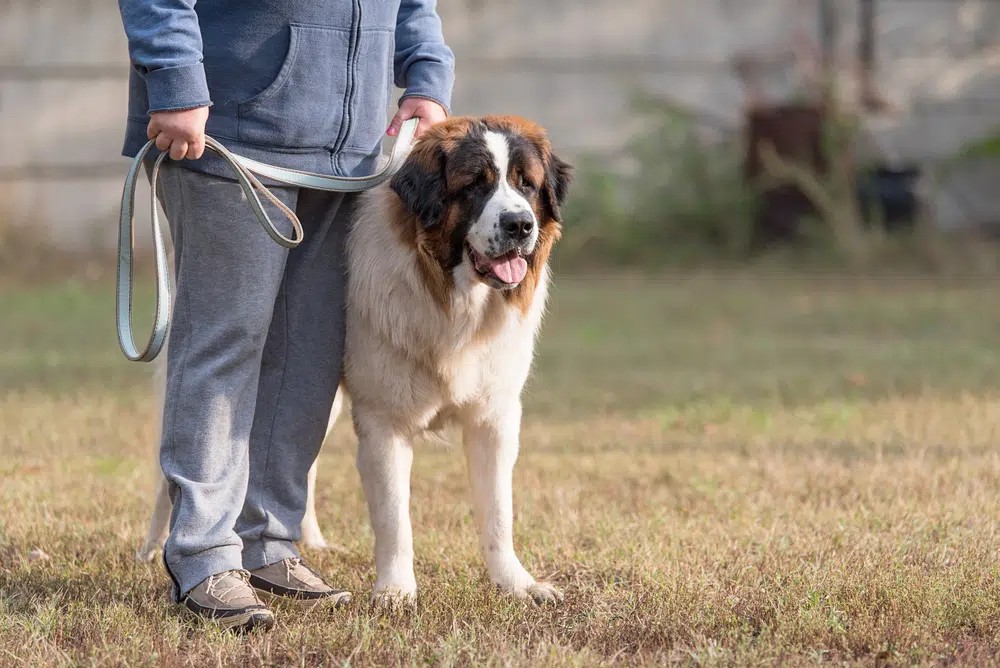Are St Bernards Good Family Pets? Absolutely! These gentle giants are renowned for their loyalty, affection, and protective nature, making them wonderful companions for the right family. At PETS.EDU.VN, we provide expert guidance on everything you need to know about Saint Bernards, from their unique characteristics to their specific care requirements, ensuring you can make an informed decision about whether this breed is the perfect fit for your lifestyle. Discover how these dogs excel as family members and learn to address potential challenges with our comprehensive resources on large breed health, training, and socialization.
1. Understanding the Saint Bernard Breed
The Saint Bernard, a breed steeped in history and known for its impressive size and gentle demeanor, has earned a special place in the hearts of dog lovers worldwide. Originating in the Swiss Alps, these dogs were initially bred by monks to rescue travelers stranded in the treacherous mountain passes. Their remarkable strength, endurance, and keen sense of smell made them invaluable assets in search and rescue operations. Today, the Saint Bernard retains its heroic reputation and is cherished as a loving and loyal family companion. Understanding their background and unique traits is the first step in determining if a Saint Bernard is the right fit for your home.
1.1 Historical Significance
The Saint Bernard’s lineage can be traced back to the mid-17th century, although tales of the Augustine monks and their remarkable dogs date back even further to the 11th century. The breed derives its name from the Great Saint Bernard Pass, a perilous route connecting Switzerland and Italy, where the monks established a hospice to aid travelers. These dogs were instrumental in saving countless lives, often venturing out in blizzard conditions to locate and assist those in need. This legacy of bravery and compassion is deeply ingrained in the Saint Bernard’s character.
1.2 Breed Characteristics
| Characteristic | Description |
|---|---|
| Height | 26–30 inches |
| Weight | 120–180 pounds |
| Lifespan | 8–10 years |
| Colors | Brown, mahogany, orange, red, brindle, rust, white, black |
| Temperament | Loyal, gentle, protective, intelligent, curious |
| Suitability | Active families or singles looking for a large and affectionate dog |
| AKC Group | Working Group |
| Fun Fact | The Saint Bernard ranks 56th in popularity among breeds recognized by the American Kennel Club (AKC). |



2. Temperament and Personality of Saint Bernards
One of the most appealing aspects of the Saint Bernard is its gentle and affectionate nature. These dogs are known for their loyalty, patience, and eagerness to please, making them wonderful companions for families. While they may appear intimidating due to their size, Saint Bernards are typically calm and good-natured, thriving on human interaction and companionship.
2.1 Loyalty and Affection
Saint Bernards form strong bonds with their families and are fiercely loyal to their loved ones. They enjoy spending time with their owners, whether it’s cuddling on the couch, going for walks, or participating in family activities. Their affectionate nature makes them excellent emotional support animals, providing comfort and companionship to those in need.
2.2 Protective Instincts
As descendants of working dogs bred to rescue travelers, Saint Bernards possess a natural protective instinct. They are vigilant watchdogs, always alert to potential threats to their families and homes. While they may be wary of strangers, Saint Bernards are not typically aggressive unless they perceive a direct threat. Early socialization and training can help channel their protective instincts in a positive manner.
2.3 Intelligence and Trainability
Saint Bernards are intelligent dogs, capable of learning a wide range of commands and tricks. However, they also possess an independent streak, which can sometimes make training a challenge. Consistency, patience, and positive reinforcement techniques are essential when training a Saint Bernard. Rewarding desired behaviors with treats, praise, or toys can motivate them to learn and obey.
3. Are Saint Bernards Good with Children?
Saint Bernards are generally considered to be good with children, earning them the nickname “gentle giants.” Their patient and tolerant nature makes them ideal companions for kids of all ages. However, it’s essential to supervise interactions between Saint Bernards and young children, as their large size could unintentionally lead to accidents.
3.1 Supervision and Safety
Due to their size, Saint Bernards may not always be aware of their own strength. They could accidentally knock over or step on small children during playtime. Supervising interactions between Saint Bernards and young children is crucial to ensure the safety of both the dog and the child. Teaching children how to interact respectfully with dogs, such as avoiding pulling their ears or tails, can also help prevent accidents.
3.2 Temperament Considerations
While Saint Bernards are generally good-natured, every dog is an individual with its own unique personality. Some Saint Bernards may be more tolerant of children than others. It’s important to assess the individual dog’s temperament and comfort level around children before leaving them unsupervised.
3.3 Socialization
Early socialization is key to ensuring that a Saint Bernard is comfortable and confident around children. Exposing them to a variety of children of different ages and personalities can help them develop positive associations with kids. Supervised playdates and interactions can help them learn how to interact appropriately with children.
4. Compatibility with Other Pets
Saint Bernards can often get along well with other pets, especially if they are raised together from a young age. However, their history as watchdogs may make them less welcoming of unfamiliar animals. Proper socialization and training are essential to ensure harmonious relationships between Saint Bernards and other pets.
4.1 Socialization with Other Dogs
Introducing a Saint Bernard puppy to other dogs early in life can help them develop positive social skills. Supervised playdates and interactions with friendly, well-behaved dogs can teach them how to interact appropriately with other canines. It’s important to monitor their interactions closely and intervene if any signs of aggression or dominance arise.
4.2 Interactions with Cats and Other Animals
Saint Bernards typically have a low prey drive, meaning they are less likely to chase or harm cats and other small animals. However, it’s still important to supervise their interactions, especially in the beginning. Providing separate spaces for each pet and allowing them to gradually acclimate to each other can help prevent conflicts.
4.3 Addressing Watchdog Instincts
Saint Bernards were historically bred as watchdogs, which means they may be naturally inclined to protect their territory from unfamiliar animals. Training can help redirect this behavior and teach them to accept other pets as part of the family. Consistency and positive reinforcement are key to success.
5. Essential Care Requirements for Saint Bernards
Owning a Saint Bernard comes with unique care requirements due to their large size and specific needs. Providing proper nutrition, exercise, training, grooming, and veterinary care is essential to ensure their health and well-being.
5.1 Nutritional Needs
Saint Bernards require a high-quality diet formulated for large breeds to support their growth and development. Puppy food should be specifically designed for large breeds to prevent rapid growth, which can lead to joint problems. Adult Saint Bernards should be fed a balanced diet that meets their energy needs without causing them to become overweight.
- Puppies (up to 18 months): Feed 3-4 times daily with large-breed puppy food.
- Adults (18 months and older): Feed twice daily with adult large-breed formula.
5.2 Exercise Requirements
While Saint Bernards are not excessively energetic, they still require regular exercise to maintain their physical and mental health. Daily walks, playtime in the yard, and occasional hikes can help them stay in shape and prevent boredom. However, it’s important to avoid overexertion, especially during hot weather, as they are prone to overheating.
- Adults: Aim for at least 30 minutes of moderate exercise per day.
- Puppies: Shorter, more frequent play sessions are better than long, strenuous workouts.
5.3 Training and Socialization
Early training and socialization are crucial for Saint Bernards to ensure they develop into well-behaved and well-adjusted adults. Enrolling in obedience classes, attending puppy playdates, and exposing them to a variety of people, places, and situations can help them become confident and sociable dogs. Positive reinforcement techniques are the most effective way to train a Saint Bernard.
5.4 Grooming Needs
Saint Bernards have thick, double-layered coats that require regular grooming to prevent matting and shedding. Weekly brushing can help remove loose hair and keep their coat healthy and shiny. During shedding season, more frequent brushing may be necessary. Regular nail trims, ear cleaning, and dental care are also essential for maintaining their overall health.
- Brushing: Weekly, more often during shedding season.
- Nail Trims: As needed, usually every 2-3 weeks.
- Ear Cleaning: Weekly, to prevent infections.
- Bathing: As needed, usually every few months.
5.5 Health Considerations
Saint Bernards are prone to certain health issues, including hip dysplasia, elbow dysplasia, bloat, and eye problems. Regular veterinary checkups and preventative care can help detect and manage these conditions early on. Choosing a reputable breeder who screens their dogs for genetic health problems can also reduce the risk of these issues.
6. Potential Health Issues in Saint Bernards
Like all breeds, Saint Bernards are predisposed to certain health conditions. Understanding these potential issues and taking preventative measures can help ensure a long and healthy life for your Saint Bernard.
6.1 Common Health Problems
| Condition | Description |
|---|---|
| Hip Dysplasia | A genetic condition where the hip joint doesn’t develop properly, leading to arthritis and pain. |
| Elbow Dysplasia | Similar to hip dysplasia, but affecting the elbow joint. |
| Bloat (Gastric Torsion) | A life-threatening condition where the stomach twists, trapping gas and fluids. Requires immediate veterinary attention. |
| Eye Issues | Entropion (inward rolling of the eyelid) and ectropion (outward rolling of the eyelid) are common. |
| Diabetes | A metabolic disorder where the body doesn’t produce enough insulin or can’t use it effectively. |
| Degenerative Myelopathy | A progressive spinal cord disease that causes weakness and paralysis, typically affecting older dogs. |
6.2 Preventative Care
Regular veterinary checkups are essential for detecting and managing potential health problems in Saint Bernards. Vaccinations, parasite control, and dental care are also important aspects of preventative care. Feeding them a high-quality diet and maintaining a healthy weight can help reduce the risk of certain health conditions.
6.3 Genetic Testing
Genetic testing can help identify dogs that are carriers of certain genetic diseases, allowing breeders to make informed decisions about breeding pairs. The Orthopedic Foundation for Animals (OFA) recommends pre-breeding screenings, exams, and DNA tests to minimize the risk of hereditary conditions.
7. Choosing a Saint Bernard Puppy
If you’ve decided that a Saint Bernard is the right breed for you, the next step is to find a reputable breeder or rescue organization. Choosing a healthy and well-socialized puppy is essential to ensure a positive experience.
7.1 Reputable Breeders
When choosing a breeder, look for someone who is knowledgeable about the breed, screens their dogs for genetic health problems, and provides a clean and stimulating environment for their puppies. A good breeder will be happy to answer your questions and provide references from previous buyers.
7.2 Rescue Organizations
Adopting a Saint Bernard from a rescue organization can be a rewarding experience. Many Saint Bernards end up in shelters through no fault of their own, and rescue organizations work tirelessly to find them loving homes. Adopting an adult dog allows you to skip the puppy stage and know the dog’s temperament and personality upfront.
7.3 Health Guarantees
A reputable breeder should offer a health guarantee for their puppies, which typically covers certain genetic health problems for a specific period of time. Review the terms of the health guarantee carefully before making a purchase.
8. Male vs. Female Saint Bernards
There are some differences between male and female Saint Bernards that may influence your decision when choosing a puppy.
8.1 Size Differences
Male Saint Bernards are typically larger and heavier than females. Males can weigh up to 180 pounds, while females typically weigh between 120 and 140 pounds. This size difference may be a factor to consider if you have limited space or prefer a smaller dog.
8.2 Temperament Similarities
The temperament of male and female Saint Bernards is generally comparable, especially with proper training and socialization. Both sexes are known for their loyalty, affection, and gentle nature. However, individual personalities can vary, so it’s important to assess each dog’s temperament individually.
8.3 Factors Influencing Personality
While genetics play a role in shaping a dog’s personality, environmental factors also have a significant impact. Early socialization, training, and consistent care can help shape a Saint Bernard’s personality, regardless of their sex.
9. Addressing Common Concerns About Saint Bernards
Potential owners may have concerns about certain aspects of owning a Saint Bernard, such as their size, drooling, and potential health issues. Addressing these concerns head-on can help you make an informed decision about whether this breed is the right fit for you.
9.1 Managing Size
Saint Bernards are large dogs that require plenty of space to move around comfortably. They need a spacious home with a large yard where they can exercise and play. If you live in a small apartment or don’t have a yard, a Saint Bernard may not be the best choice for you.
9.2 Dealing with Drooling
Saint Bernards are known for their drooling, which can be a nuisance for some owners. Carrying a towel with you when you’re with your dog can help manage the drool. Regular grooming can also help minimize drooling by removing excess saliva and keeping their mouth clean.
9.3 Mitigating Health Risks
Choosing a reputable breeder who screens their dogs for genetic health problems can help reduce the risk of certain health issues. Regular veterinary checkups and preventative care can also help detect and manage health problems early on.
10. Saint Bernard FAQs
Here are some frequently asked questions about Saint Bernards:
-
Are Saint Bernards good for first-time dog owners?
Saint Bernards can be a good choice for first-time dog owners who are willing to dedicate time and effort to training and socialization. Their gentle nature and eagerness to please make them relatively easy to train. However, their size and specific care requirements may be challenging for some first-time owners.
-
How much exercise do Saint Bernards need?
Saint Bernards need at least 30 minutes of moderate exercise per day. Daily walks, playtime in the yard, and occasional hikes can help them stay in shape and prevent boredom. However, it’s important to avoid overexertion, especially during hot weather.
-
Are Saint Bernards easy to train?
Saint Bernards are intelligent dogs that can be relatively easy to train with consistent and positive reinforcement techniques. However, their independent streak may require patience and persistence.
-
Do Saint Bernards shed a lot?
Saint Bernards shed moderately year-round and heavily during shedding season (spring and fall). Regular brushing can help minimize shedding and keep their coat healthy.
-
Are Saint Bernards good with cats?
Saint Bernards can get along well with cats if they are raised together from a young age. However, it’s important to supervise their interactions, especially in the beginning.
-
What is the average lifespan of a Saint Bernard?
The average lifespan of a Saint Bernard is 8-10 years.
-
What are the most common health problems in Saint Bernards?
Common health problems in Saint Bernards include hip dysplasia, elbow dysplasia, bloat, and eye problems.
-
How much do Saint Bernards cost?
The cost of a Saint Bernard puppy from a reputable breeder can range from $1,500 to $3,000. Adoption fees from rescue organizations are typically lower.
-
What is the best diet for a Saint Bernard?
The best diet for a Saint Bernard is a high-quality diet formulated for large breeds. Puppy food should be specifically designed for large breeds to prevent rapid growth.
-
How big do Saint Bernards get?
Male Saint Bernards can weigh up to 180 pounds and stand 28-30 inches tall. Females typically weigh between 120 and 140 pounds and stand 26-28 inches tall.
Final Thoughts: Is a Saint Bernard Right for You?
The Saint Bernard is a magnificent breed with a rich history and a gentle, loving nature. They make wonderful family pets for those who are prepared to meet their unique needs. By understanding their temperament, care requirements, and potential health issues, you can make an informed decision about whether a Saint Bernard is the right fit for your lifestyle. Remember to visit PETS.EDU.VN for more in-depth guides and resources on Saint Bernard care, training, and health.
Are St Bernards good family pets? Yes, if you’re prepared to provide the love, care, and attention they deserve.
For more information and expert advice, contact us:
Address: 789 Paw Lane, Petville, CA 91234, United States
WhatsApp: +1 555-987-6543
Website: pets.edu.vn
